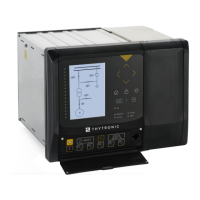
Do you have a question about the Thytronic XMR-T and is the answer not in the manual?
| Rated Current | 5A |
|---|---|
| Mounting | DIN Rail |
| Current Rating | 5A |
| Protection Class | IP20 |
| Housing Material | Plastic |
| Communication | Modbus RTU |
| Operating Temperature | -20°C to +60°C |
| Protection Functions | Overcurrent, Earth Fault |
Defines the scope, limitations, and liabilities associated with the relay's technical characteristics and usage instructions.
Details the product's compliance with relevant CEE directives for EMC and Low Voltage.
Provides contact information for technical assistance and service.
States the rights reserved by the manufacturer and restrictions on copying or modifying the document.
Outlines the warranty period and conditions for the device against defects.
Crucial information on safe installation, operation, and handling, using hazard symbols.
Specifies requirements and precautions for insulation testing to ensure electrical safety.
Describes the information found on the device's identification and test labels.
Outlines conditions for proper device operation and necessary provisions for different environments.
Explains symbols and text formats used throughout the manual for clarity.
Provides definitions for technical terms and ANSI codes used in the manual.
Introduces the relay's purpose, application scope, and system compatibility for general protection.
Provides a visual representation of the XMR-T relay device.
Lists the key hardware and operating features, including case, display, LEDs, inputs/outputs, and communication interfaces.
Details the security features implemented in XMR Relays to mitigate cyber threats and ensure data privacy.
Covers general technical specifications including mechanical, insulation, EMC, emission, safety, and certifications.
Details specifications for auxiliary power supply, current, voltage, binary inputs, and block input circuits.
Specifies the quantity, type, and ratings for the device's output relays.
Lists the components of the Man Machine Interface module, including display, keyboard, and LEDs.
Details specifications for local Ethernet/RS232 ports and network Ethernet/RS485 ports and protocols.
Specifies rated values for voltage, current, frequency, and phase/residual settings for various versions.
Details the characteristics, settings, and logic diagrams for various protection functions like overcurrent, overvoltage, and thermal.
Covers functions like harmonic restraint, trip circuit supervision, selective blocks, breaker failure, and CT/VT supervision.
Provides accuracy values for various measured quantities including current, voltage, power, and frequency.
Details the device layout, power supply, CPU module, analogue processing, input board, and MMI components.
Explains the firmware structure including base software, RTOS, tasks, DSP, drivers, application software, and communication protocols.
Details metering inputs, signal processing levels (direct, calculated, sequence, demand), power, energy, and conventions.
Specifies the rated values for setting protection elements, including reference names, frequency, currents, and voltages.
Covers functions such as remote tripping, harmonic restraint, CT/VT supervision, trip circuit supervision, virtual I/O, CB supervision, oscillography, and arc flash protection.
Lists various direct and calculated measures, including currents, voltages, sequence components, and thermal data.
Indicates available settings for each protection threshold, including Start/Trip status, logic blocks, and Cold Load Pickup.
Shows the availability of binary input states acquired downstream of delay timers.
Details the self-diagnosis function, its management, and the information provided on anomalies.
Provides information on pilot wire diagnostic states, including breaking and short-circuit detection.
Describes the packaging materials and recommendations for transport and storage conditions.
Covers mounting options like flush and rack mounting, including drilling distances and wiring space.
Details the terminal specifications, cross-sections, and connection guidelines for various circuits.
Explains how to set relay rated currents via ThyVisor software.
Describes the function and assignability of front panel LEDs, including ON/Diagnostic, Start, Trip, and programmable LEDs.
Lists essential checks before energizing the electric board, such as auxiliary voltage, CT settings, wiring, and screws.
Provides information on downloading and installing the ThyVisor software and its template setup.
Explains how to perform settings, reading, and modification operations using the front panel buttons and display.
Details the step-by-step procedure for modifying setting parameters via the MMI, including confirmation and abort options.
Explains how to activate operational tests for selected output relays and browse the TEST menu.
Guides on reading and modifying RS485 Protocol and Ethernet parameters through the COMMUNICATION menu.
Describes how to issue CB opening and closing commands using dedicated keys and enabling output relays.
Explains how to enable or disable parameter changes via the MMI using a password or factory setting.
Discusses the relay's low maintenance requirements and the conditions under which periodic checks are advisable.
States that client repairs are not foreseen and faulty units must be sent to the factory.
Reiterates storage conditions regarding temperature and humidity.
Provides detailed diagrams of input and output connections for different XMR-T configurations.
Lists all available protective and control elements and their corresponding ANSI codes and page numbers.
Illustrates typical application schemes showing how protection functions are interconnected within the relay.
Declares the product's conformity with EC directives and lists applied harmonized standards and technical specifications.